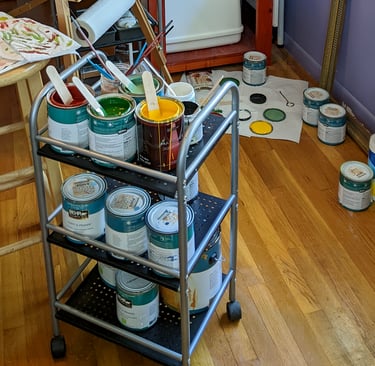What's the right paint for interior murals?
There are right and wrong paints to use for painting an interior mural. The right paint for interior murals meets the needs of the room. Let's look at what the right paints can do for you.
Kathy LaFollett
1/17/20243 min read


There are right and wrong paints to use for painting an interior mural. Let's look at what the right paints can do for you. The first thing you want a good paint to do for you is feel good while you paint.
Interior paint—Low no VOC, brands, matte, semi, gloss, high gloss
Artist's acrylics—brands, pigments, costs, gloss additives.
Drywall, painted drywall, wood, brick, stucco, older stained drywall.
Killz Primer
Which interior paint brand is best for mural painting?
I've settled on Behr paints as my go-to mural medium. Price point, collective paint chip gallery, pigment quality, and viscosity well suited for an artist's brush put Behr in first place. The decision took a handful of mural jobs using Behr, Glidden, Valspar, and Sherwin Williams.
Feel while painting needs to be your primary concern. No amount of money saved, or convenience will replace an enjoyable painting experience. The best way to decide what brand you prefer to work with is by purchasing a square of drywall patch (at any big box hardware) and one sample of each brand. Stick with one color for all as well as your choice between matte, semi, and gloss. Using a synthetic, then blended or natural brush, paint your way through each brand on the drywall patch. Small and large brush strokes. You'll soon find the 'feel' you're most comfortable with in painting.
Once you’ve got your brand, stick with their low/no VOC products. I work a majority of my projects in matte. For your first mural I suggest you stay inside the matte as well. You’ll have plenty to think about other than the sometimes-complex issues semi and gloss create.
Can a wall mural be done in artists’ acrylics paint?
Yes. But. Artistic acrylics, scholastic to professional, do not have the coverage or feel of interior paint. They’re meant for canvas, board, and paper. You’ll find yourself using more paint with less color impact on the whole. You’ll also need to purchase gloss, UV protecting, and sealant additives to mix into the paints that already exist in interior acrylic. Increasing workload, decreasing color impact, and adding heavy costs. Not to mention more bottles and containers creating chaos where you’re working. If you’re painting a wall, use interior paints. They’re meant for that lifestyle.
What surfaces can interior paints be applied to?
Drywall, painted drywall, wood, brick, stucco, and wallpapered. Whatever surface you’re looking at, preparing and priming properly is mandatory for the success and longevity of your art.
The wall is your canvas. Your canvas needs to be clean, even, clear of debris, and primed. Clean or new drywall doesn’t need a primer to support interior paints. Most interior paints are a self-priming on drywall type.
Kilz or Zinnser Primer is a muralist’s best friend. Primer creates a clean, clear, functioning surface on wood, brick, stucco, wallpaper, and older stained drywall.
If your wall is painted well, and you like the color, save a bit of time and simply clean it. You can plan your design’s color palette from there. Saving time and money.
The right paint for your wall mural is your choice.
Every artist has personal reasons for their tools and medium. Prioritize the enjoyment of the process brought by the paint itself. Every brand feels different. Test drive those brands.
Artist’s paints are meant for hanging art.
Prepare your wall for success. Clean, dry, free of debris, and consistent texture and color is your goal. If you like the color of paint on the wall, leave it and use it for the design.
Interior house paints have come a long way technically. One is not better than the other so much as they are different in subtle ways. It’s your choice, and your personal preference that will lead you to the brand you like to work with, and away from the brands that you don’t.
